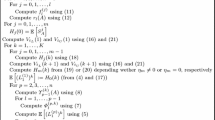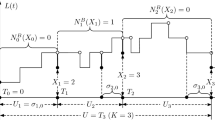Abstract
We address the probability that k or more Consecutive Customer Losses take place during a busy period of a queue, the so-called k-CCL probability, for oscillating GI X/M//n systems with state dependent services rates, also denoted as GI X/M(m)−M(m)//n systems, in which the service rates oscillate between two forms according to the evolution of the number of customers in the system. We derive an efficient algorithm to compute k-CCL probabilities in these systems starting with an arbitrary number of customers in the system that involves solving a linear system of equations. The results derived are illustrated for specific sets of parameters.
Similar content being viewed by others
References
Artalejo, J. R., & Economou, A. (2005). Markovian controllable queueing systems with hysteretic policies: busy period and waiting time analysis. Methodology and Computing in Applied Probability, 7(3), 353–378.
Bahary, E., & Kolesar, P. (1972). Multilevel bulk service queues. Operations Research, 20, 406–420.
Bratiychuk, M., & Chydzinski, A. (2003). On the ergodic distribution of oscillating queueing systems. Journal of Applied Mathematics and Stochastic Analysis, 16(4), 311–326.
Choi, B. D., & Choi, D. I. (1996). Queueing system with queue length dependent service times and its application to cell discarding scheme in ATM networks. IEEE Proceedings on Communications, 143(1), 5–11.
Choi, D. I., Knessl, C., & Tier, C. (1999). A queueing system with queue length dependent service times, with applications to cell discarding in ATM networks. Journal of Applied Mathematics and Stochastic Analysis, 12(1), 35–62.
Chydzinski, A. (2002). The M/G-G/1 oscillating queueing system. Queueing Systems, 42(3), 255–268.
Chydzinski, A. (2004a). On the remaining service time upon reaching a given level in M/G/1 queues. Queueing Systems, 47(1–2), 71–80.
Chydzinski, A. (2004b). The oscillating queue with finite buffer. Performance Evaluation, 57(3), 341–355.
Chydzinski, A. (2005). On the distribution of consecutive losses in a finite capacity queue. WSEAS Transactions on Circuits and Systems, 4(3), 117–124.
de Boer, P.-T. (2000). Analysis and efficient simulation of queueing models of telecommunication systems. Ph.D. thesis, Centre for Telematics and Information Technology, University of Twente, The Netherlands.
de Boer, P.-T., & Nicola, V. F. (1998). Hybrid importance sampling estimation of consecutive cell loss probability. AEÜ International Journal of Electronics and Communications, 52(3), 133–140.
de Boer, P.-T., Nicola, V. F., & van Ommeren, J.-K. C. W. (2001). The remaining service time upon reaching a high level in M/G/1 queues. Queueing Systems, 39(1), 55–78.
Dshalalow, J. H. (1997). Queueing systems with state dependent parameters. In Frontiers in queueing: models and applications in science and engineering (pp. 61–116). Boca Raton: CRC.
Federgruen, A., & Tijms, H. C. (1980). Computation of the stationary distribution of the queue size in an M/G/1 queueing system with variable service rate. Journal of Applied Probability, 17(2), 515–522.
Ferreira, F., & Pacheco, A. (2006). Analysis of GI/M/s/c queues using uniformisation. Computers and Mathematics with Applications, 51(2), 291–304.
Golub, G. H., & van Loan, C. F. (1996). Matrix computations (3rd ed.). Baltimore: Hopkins.
Golubchik, L., & Lui, J. C. S. (2002). Bounding of performance measures for threshold-based queuing systems: Theory and application to dynamic resource management in video-on-demand servers. IEEE Transactions on Computers, 51(4), 353–372.
Harris, T. J. (1971). The remaining busy period of a finite queue. Operations Research, 19, 219–223.
Ibe, O. C., & Keilson, J. (1995). Multi-server threshold queues with hysteresis. Performance Evaluation, 21(3), 185–213.
Kant, L., & Sanders, W. H. (1995). Loss process analysis of the knockout switch using stochastic activity networks. In Procs. 4th international conference on computer communications and networks, Sept. 20–23, 1995 (pp. 344–349).
Kulkarni, V. G. (1995). Modeling and analysis of stochastic systems. London: Chapman and Hall.
Kwiatkowska, M., Norman, G., & Pacheco, A. (2002). Model checking CSL until formulae with random time bounds. In Lecture notes in computer science (Vol. 2399, pp. 152–168). Berlin: Springer
Lee, C., & Andersland, M. (1996). Consecutive cell loss controls for leaky-bucket admission systems. In Procs. of Globecom’96 (Vol. 3, pp. 1732–1738).
Lee, C. W., & Andersland, M. S. (1994). Minimizing consecutive packet loss in real-time ATM sessions. In Procs. of Globecom’94 (Vol. 2, pp. 935–940).
Li, S.-Q. (1989). Overload control in a finite message storage buffer. IEEE/ACM Transactions on Communications, 37(12), 1330–1337.
Loris-Teghem, J. (1981). Hysteretic control of an M/G/1 queueing system with two service time distributions and removable server. In Colloq. Math. Soc. János Bolyai : Vol. 24. Point processes and queuing problems (pp. 291–305). Amsterdam: North-Holland.
Lu, F. V., & Serfozo, R. F. (1984). M/M/1 queueing decision processes with monotone hysteretic optimal policies. Operations Research, 32(5), 1116–1132.
Pacheco, A., & Ribeiro, H. (2006). Consecutive customer loss probabilities in M/G/1/n and GI/M(m)//n systems. In Procs. workshop on tools for solving structured Markov chains, Pisa, Italy, October 10, 2006.
Peköz, E. A., Righter, R., & Xia, C. H. (2003). Characterizing losses during busy periods in finite buffer systems. Journal of Applied Probability, 40(1), 242–249.
Resnick, S. (1992). Adventures in stochastic processes. Boston: Birkhäuser.
Rhee, H.-K., & Sivazlian, B. D. (1990). Distribution of the busy period in a controllable M/M/2 queue operating under the triadic (0,K,N,M) policy. Journal of Applied Probability, 27(2), 425–432.
Robert, P. (2003). Stochastic networks and queues. Berlin: Springer.
Sriram, K., & Lucantoni, D. (1989). Traffic smoothing effects of bit dropping in a packet voice multiplexer. IEEE Transactions on Communications, 37(7), 703–712.
Sriram, K., McKinney, R. S., & Sherif, M. H. (1991). Voice packetization and compression in broadband ATM networks. IEEE Journal on Selected Areas in Communications, 9(3), 294–304.
Takine, T., Suda, T., & Hasegawa, T. (1995). Cell loss and output process analyses of a finite-buffer discrete-time ATM queueing system with correlated arrivals. IEEE Transactions on Communications, 43(2–4), 1022–1037.
Vijaya Laxmi, P., & Gupta, U. C. (2000). Analysis of finite-buffer multi-server queues with group arrivals: GI X/M/c/N. Queueing Systems, 36(1–3), 125–140.
Yadin, M., & Naor, P. (1967). On queueing systems with variable service capacities. Naval Research Logistics Quarterly, 14, 43–53.
Author information
Authors and Affiliations
Corresponding author
Additional information
This research was supported in part by Programa de Formação Avançada de Docentes do Ensino Superior Medida 5/Acção 5.3 (PRODEP III) and the Programa Operacional “Ciência, Tecnologia, Inovação” (POCTI) of the Fundação para a Ciência e a Tecnologia (FCT), cofinanced by the European Community fund FEDER, and the projects POSC/EIA/60061/2004, Euro-NGI, and Euro-FGI.
Rights and permissions
About this article
Cite this article
Pacheco, A., Ribeiro, H. Consecutive customer losses in oscillating GI X/M//n systems with state dependent services rates. Ann Oper Res 162, 143–158 (2008). https://doi.org/10.1007/s10479-008-0313-6
Received:
Accepted:
Published:
Issue Date:
DOI: https://doi.org/10.1007/s10479-008-0313-6




